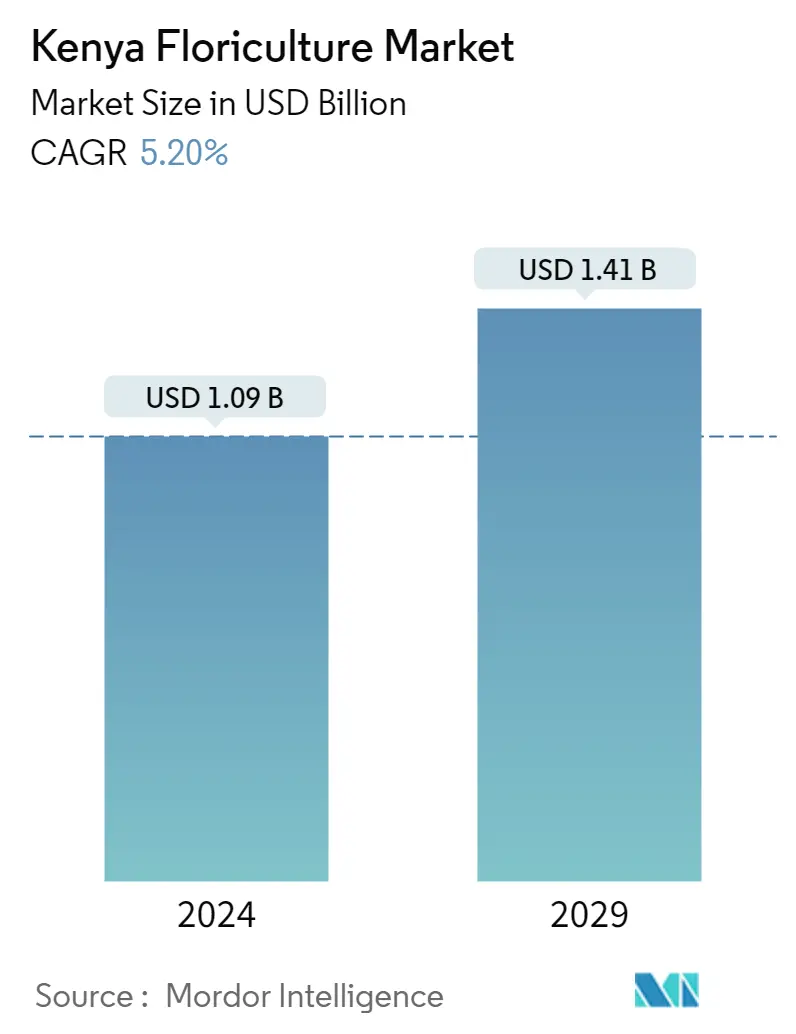Market Size of Kenya Floriculture Industry

| Study Period | 2019 - 2029 |
| Base Year For Estimation | 2023 |
| Forecast Data Period | 2024 - 2029 |
| Market Size (2024) | USD 1.09 Billion |
| Market Size (2029) | USD 1.41 Billion |
| CAGR (2024 - 2029) | 5.20 % |
Major Players*Disclaimer: Major Players sorted in no particular order |
Kenyan Floriculture Market Analysis
The Kenya Floriculture Market size is estimated at USD 1.09 billion in 2024, and is expected to reach USD 1.41 billion by 2029, growing at a CAGR of 5.20% during the forecast period (2024-2029).
- Kenya's economy is heavily reliant on agriculture. The floriculture sub-sector is one of the country's leading foreign exchange earners. The Kenyan flowers are exported to over 60 nations. The flowers grown mainly in Kenya are roses, carnations, alstromeria, gypsophilla, lilies eryngiums, arabicum, hypericum, and statice, among others. The favorable climatic conditions are increasing the production of flowers in the country, which drives the market's growth.
- Additionally, the industry employs a vast number of people in the country. According to the Embassy of the Republic of Kenya in Japan, it is estimated that the floriculture business employs over 500,000 Kenyans, including over 100,000 flower farm workers, and affects over 2 million livelihoods. The production takes place around Lake Naivasha, Mt. Kenya, Nairobi, Thika, Kiambu, Athi River, Kitale, Nakuru, Kericho, Nyandarua, Trans Nzoia, Uasin Gishu, and Eastern Kenya.
- Along with this, rose is witnessing immense popularity in the country. Delphinium, Limonium, and Helianthus are the most popular growing facilities for roses in Kenya. It is a leading exporter of rose-cut flowers to the European Union (EU). Its total exports of cut roses were valued at USD 550.9 million in 2021.
- Furthermore, some of the most common technologies utilized in the entire cold chain of Kenyan flower farming include drip irrigation, fertigation systems, glasshouse ventilation systems, net shading, pre-cooling, cold storage facilities, artificial lightning, and refrigerated trucks. Therefore, the usage of the improved technologies produces good quality flowers, thereby contributing to the market growth in the forecast period.
Kenyan Floriculture Industry Segmentation
Floriculture is a type of horticulture practice that primarily focuses on the cultivation of flowering and ornamental plants for gardens and commercial use.
The Kenyan floriculture market is segmented by type of flower into roses, carnations, lilies, hypericum, gypsophilia, and other cut flowers, cuttings, and other types of flowers. The report includes the production (volume), consumption (volume and value), import (volume and value), export (volume and value), and price trend analyses of the above-mentioned segments.
The report offers market size and forecasts in terms of Value (USD million) and volume (metric ton) for all the above segments.
| Types of Flowers | |||||||||||
|
Kenya Floriculture Market Size Summary
The floriculture industry in Kenya is a significant contributor to the country's economy, serving as a major foreign exchange earner and employing a substantial workforce. The sector thrives due to favorable climatic conditions, which support the cultivation of various flowers such as roses, carnations, and lilies. Kenya's strategic location and advanced agricultural practices, including the use of modern technologies like drip irrigation and glasshouse systems, enhance the quality and quantity of flower production. The industry is predominantly export-oriented, with a significant portion of its flowers being shipped to European countries, particularly the Netherlands, the United Kingdom, Germany, and Norway. The government's supportive policies and investments in infrastructure and technology further bolster the sector's growth prospects.
Kenya's floriculture market is poised for continued expansion, driven by increasing global demand for cut flowers and the country's established reputation as a leading exporter. The industry benefits from a well-developed supply chain and logistical support, with initiatives aimed at improving export capabilities and market access. The government's focus on smallholder farmer aggregation and the establishment of quarantine facilities are key strategies to enhance export volumes and diversify markets. Additionally, partnerships with international organizations and investments in market infrastructure are expected to strengthen Kenya's position in the global floriculture market. The ongoing adoption of innovative farming techniques and the expansion of production areas contribute to the sector's robust growth trajectory.
Kenya Floriculture Market Size - Table of Contents
-
1. MARKET DYNAMICS
-
1.1 Market Overview
-
1.2 Market Drivers
-
1.3 Market Restraints
-
-
2. MARKET SEGMENTATION (Production Analysis in Volume, Consumption Analysis by Volume and Value, Import Analysis by Value and Volume, Export Analysis by Value and Volume, and Price Trend Analysis)
-
2.1 Types of Flowers
-
2.1.1 Cut Flowers
-
2.1.1.1 Roses
-
2.1.1.1.1 Carnations
-
2.1.1.1.2 Lilies
-
2.1.1.1.3 Hypericum
-
2.1.1.1.4 Gypsophila
-
2.1.1.1.5 Other Cut Flowers
-
-
2.1.1.2 Cuttings
-
2.1.1.3 Other Types of Flowers
-
-
-
Kenya Floriculture Market Size FAQs
How big is the Kenya Floriculture Market?
The Kenya Floriculture Market size is expected to reach USD 1.09 billion in 2024 and grow at a CAGR of 5.20% to reach USD 1.41 billion by 2029.
What is the current Kenya Floriculture Market size?
In 2024, the Kenya Floriculture Market size is expected to reach USD 1.09 billion.

